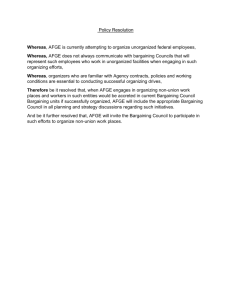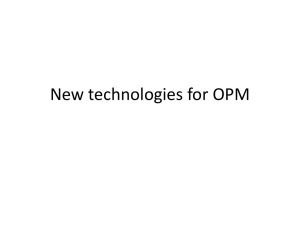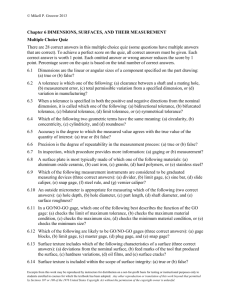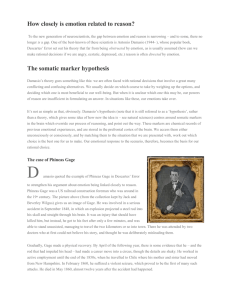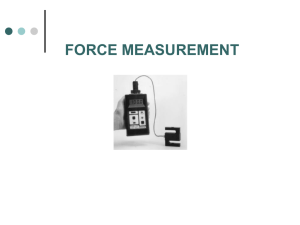John Gage
advertisement
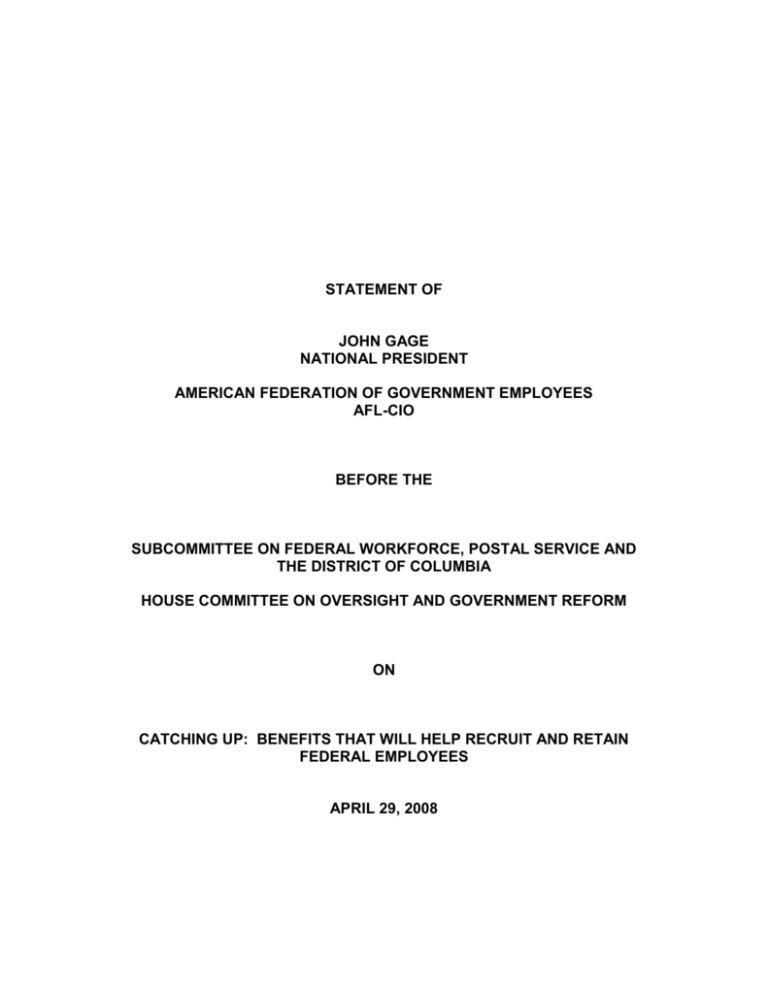
STATEMENT OF
JOHN GAGE
NATIONAL PRESIDENT
AMERICAN FEDERATION OF GOVERNMENT EMPLOYEES
AFL-CIO
BEFORE THE
SUBCOMMITTEE ON FEDERAL WORKFORCE, POSTAL SERVICE AND
THE DISTRICT OF COLUMBIA
HOUSE COMMITTEE ON OVERSIGHT AND GOVERNMENT REFORM
ON
CATCHING UP: BENEFITS THAT WILL HELP RECRUIT AND RETAIN
FEDERAL EMPLOYEES
APRIL 29, 2008
Mr. Chairman and Members of the Subcommittee: My name is John
Gage. I am the National President of the American Federation of Government
Employees, AFL-CIO (AFGE). On behalf of the more than 600,000 federal
employees represented by AFGE, I thank you for the opportunity to testify today
on the issue of health insurance coverage for the young adult dependents of
federal employees.
Extending health insurance coverage through the Federal Employees
Health Benefits Program (FEHBP) to dependents up to age 25 has long been a
priority for AFGE’s members. Many children of federal employees are forced to
delay completion of college degrees because they must work to earn the money
necessary to pay the ever-increasing tuition and fees charged by institutions of
higher learning. These young adults may also remain economic dependents of
their federal employee parents until age 25 because they are pursuing the
advanced degrees which are increasingly necessary even for entry-level jobs in
some professional occupations. Finally, a large number of young adults whose
parents are federal employees are in the workforce but hold jobs that provide
either no employer-sponsored health insurance or health insurance options that
are entirely unaffordable.
According to the Robert Wood Johnson Foundation, as of 2004,
approximately 13.7 million Americans between the age of 19 and 29 were
uninsured. Unless they are either full-time students, or their parents’ full-time
caregivers, they, for the most part, lose eligibility for coverage under their
parents’ family coverage. In the FEHBP, unmarried children can be covered up
until the age of 22. Only in rare circumstances, such as when the child is
incapable of supporting him or herself because of a disability that began before
age 22, will FEHBP continue to cover dependents over that age. Fourteen states
have passed legislation that to some degree redefines “dependent” for purposes
of family health insurance coverage, and the majority of those have extended
coverage to the age of 25.
The legislation introduced by Chairman Danny K. Davis, H.R. 5550, was
an attempt to bring the federal government up to the standards set by these
progressive states and other employers against whom the federal agencies
compete to recruit and retain employees. AFGE strongly supports H.R. 5550
because it provides a straightforward answer to the problem of insurance
coverage for the young adult dependents of federal employees. The actual costs
to FEHBP of extending family coverage to those in the age interval of 22 to 25
are likely to be negligible, but the benefit to families would be substantial.
The compromise forced upon the Subcommittee, which would have the
Office of Personnel Management (OPM) make available for purchase a separate
insurance policy for the young adult dependents of federal employees, is
unfortunate. Even though there is absolutely no evidence that anyone meant for
{00247942.DOC}
2
this compromise to constitute a model for future efforts to improve health
insurance for federal employees and their families, it must be acknowledged that
employee-pay-all insurance products are not employee benefits. Because the
current legislation would require federal employees who have uninsured
dependents between the ages of 22 and 25 to purchase separate policies for
them outside the FEHBP, it is unclear how many would be able to afford
coverage, especially those with large families. In light of the fact that thousands
of federal employees remain uninsured altogether because they cannot afford
FEHBP premiums, it is reasonable to conclude that there are many thousands
more in the lower grades of the General Schedule and the Federal Wage System
who barely afford the coverage they have in FEHBP and could not begin to afford
to purchase additional individual plans for their young adult dependents.
The claim that extending FEHBP family coverage to dependents up until
the age of 25 is unaffordable is especially frustrating to hear in light of the Bush
Administration’s continued refusal to take advantage of rebates made available
under the Medicare Modernization Act that, according to a Government
Accountability Office (GAO) study, would immediately cut all FEHBP premiums
by roughly two percent, and reduce future premium growth in perpetuity.
In December 2006 GAO issued a report on FEHBP premium trends, and
addressed OPM's decision not to take advantage of the fact that the law
establishing the Medicare Part D prescription drug program allowed subsidies for
employers who provided their retirees with prescription drug coverage. 1 GAO
surveyed both small and large FEHBP plans and all agreed that that the retiree
drug subsidy would have had some effect on premium growth if OPM had
applied for the subsidy and used it to offset premiums. (GAO-07-141 page 13).
OPM's rationale for declining the subsidy has been reported to rest on two
arguments: First, OPM does not worry that its carriers would cease offering
prescription drug coverage to retirees, as there are no separate benefit packages
in FEHBP plans between active and retired enrollees (so far), and Title 5 requires
all FEHBP plans to provide at least some prescription drug coverage. Second,
they did not interpret the statute "to require employers to use the subsidy to
mitigate premium growth." (GAO-07-141 page 14). Nevertheless, the GAO study
goes on to describe the fact that prescription drug prices are responsible for the
bulk of premium increases. Data from the five largest FEHBP plans (which cover
2/3 of the FEHBP population) between 2003 and 2005 show prescription drug
spending as causing 34% of total increases (hospital inpatient and all physician
services combined totaled only 30% of the increase, by comparison). The GAO
study further estimated that if OPM had taken advantage of the Medicare Part D
subsidy it would have reduced the average growth in premiums by 2.6% if
1
Government Accountability Office, GAO-07-141. Federal Employees Health Benefits Program:
Premium Growth has Recently Slowed, and Varies among Participating plans. Report to the Subcommittee
on Oversight of Government Management, the Federal Workforce, the District of Columbia of the Senate
Committee on Homeland Security and Government Affairs, December 2007.
{00247942.DOC}
3
applied in 2006. In plans with large retiree enrollment, the potential impact is
estimated to be as large as 3.5% to 4%.
It is not too late for OPM to apply for and receive the Medicare Part D
subsidy. If applied, it would not only reduce premiums for as long as it is applied,
it would reduce future premium inflation as long as prescription drug prices rise
faster than the prices of FEHBP’s other covered services. Since federal
employees are required by law to pay at least 25% of FEHBP premiums, and
since they pay on average 30% of premiums, and since in each of the past three
years the enrollee share of premiums has risen by a higher percentage than the
agency share, AFGE strongly urges the Congress to require OPM to obtain the
maximum amount available to FEHBP under Medicare's Part D employer subsidy
provision. We believe that these refunds are more than adequate to pay for both
an extension in eligibility for dependent coverage to age 25 as provided for in
H.R. 5550, and the improvement in FEHBP financing that is provided for in H.R.
1256.
Absent a national health insurance reform that delivers affordable
universal coverage, federal employees and their families look to FEHBP as a
means of providing health insurance for themselves and their dependents. We
commend the Chairman for introducing H.R. 5550 in recognition of the fact that
young adults who are pursing higher education, and working at jobs that provide
either no insurance, or unaffordable insurance options, continue to need
coverage through their parents’ employer-sponsored plans. We hope that many
federal employees will be able to afford the plans that OPM chooses to make
available for this age group, and that soon Congress and a new administration
will be successful in addressing in a more comprehensive way the many
problems of health care in America.
This concludes my statement. I will be happy to answer any questions
that the members of the Subcommittee may have.
{00247942.DOC}
4
John Gage
National President
American Federation of Government Employees, AFL-CIO
As National President of the American Federation of Government
Employees (AFGE), AFL-CIO, John Gage stands watch over the rights of
some 600,000 federal and D.C. government employees. Gage, who
leads the nation's largest union for government workers in some 1,100
locals in the United States and overseas, was elected national president
at AFGE's 2003 National Convention in Las Vegas, NV.
John Gage has long been involved in AFGE and the labor movement. He
has committed over twenty years of service as president of AFGE Local
1923 and as National Vice President of AFGE's 4th District. Under his
leadership, Local 1923 experienced robust growth, making it the largest
Local within the Federation. Gage brought that same energy for
organizing to his role as NVP and initiated a new organizing program
now familiarly called "Lunch and Learns." In fact, the new program
helped the 4th District sign up 6,000 members in two years. In 1985,
Gage stepped down as NVP to lead the successful defense of SSA
against a well-financed membership drive by another union.
Gage began working for the federal government as a disability examiner for the Social Security
Administration in 1974. He quickly became involved with AFGE and served as 2nd Vice President
and editor of Local 1923's newsletter. He went on to serve as Executive Vice President before being
elected President in 1982. Gage has served as chief negotiator for a number of national contracts
and describes his work as a negotiator as a labor of love. He strongly believes that good contracts
and the ability to enforce them are important keys to increasing membership.
Gage is proud of the true diversity established within Local 1923 under his leadership-including its
members, staff, officers and stewards-and will bring the same appreciation for these values as the
new leader of the Federation.
As National President, John Gage seeks to give emphasis to organizing, legal representation on
behalf of Locals, and coordinated media activities. Gage believes that capitalizing on
representational opportunities at the worksite, in the community and on the national scene draws
attention to AFGE issues. This provides a new way of performing the most fundamental mission of
AFGE-representation-and enables the union to strengthen each Local's ability to provide service,
politically mobilize, organize and communicate.
Gage serves as a trustee of the National Labor College, an accredited four year college for union
members and their families.
Gage was born in 1946 and graduated from Central Catholic High School, in Pittsburgh, PA in 1964.
He went on to study at Wheeling Jesuit University, graduating in 1968. His career includes a brief
stint as a professional baseball player with the Baltimore Orioles (1968-1969).
Gage is married to Patti McGowan, a labor lawyer for AFGE Council 220 who does pro-bono work for
the Maryland Disability Law Center.
{00247942.DOC}
5
April 24, 2008
The Honorable Danny K. Davis
Chairman
Committee on Oversight and Government Reform
2157 Rayburn House Office Building
Washington, DC 20515
Dear Chairman Davis:
The American Federation of Government Employees has not received any
federal grants or contracts, during this year or in the last two years, from any
agency or program relevant to the subject of the April 29, 2008 hearing of the
Subcommittee on Federal Workforce, Postal Service and the District of Columbia
entitled, Catching Up: Benefits That Will Help Recruit and Retain Federal
Employees.
Sincerely,
Beth Moten
Legislative and Political Director
{00247942.DOC}
6
